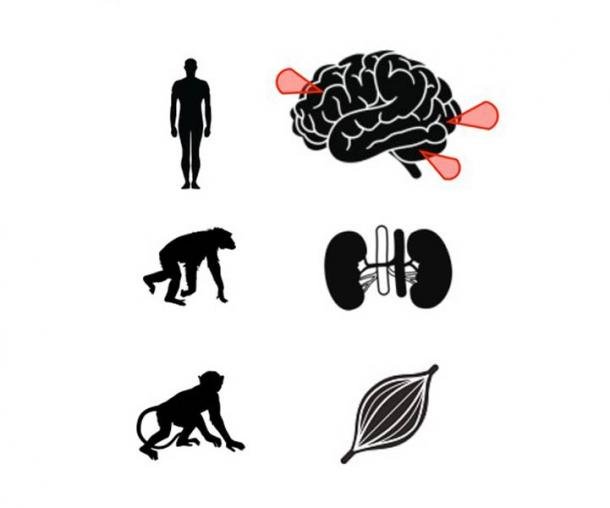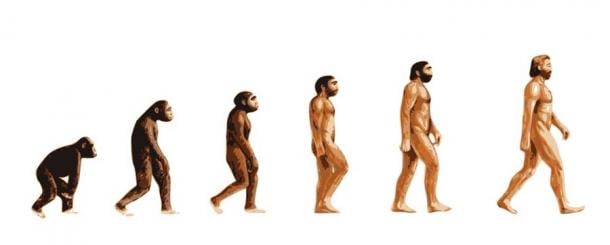An international team of scientists representing Russia, Germany, and the United States have found a unique mechanism at work in the DNA of human beings that helped shape our species’ evolution, the Skolkovo Institute of Science and Technology ( Skoltech) has just announced. The researchers believe this unusual feature, a genetic mutation, may have played a primary role in our overall evolutionary success, helping to make us smarter and more adaptable than similar species that did not survive into the modern era.
This mechanism involves a mutation in the human genetic code that affects metabolism in the brain. This mutation cannot be found in the DNA of other primate species. Notably, it was not present in the brains of our extinct archaic cousins, the Neanderthals and Denisovans, either. At this preliminary stage, the researchers cannot be certain how exactly this mutation might have helped human beings develop their advanced mental capabilities. But its existence is real and is clearly meaningful, since it affects the chemical balance of the brain.

Illustration showing the species and tissues used for metabolite measurements within the study which has identified the genetic mutation. (Stepanova et. al. / eLife)
The Creative Role of Genetic Mutation in Evolution
According to an article in Science Magazine , researchers from the Skoltech Center for Neurobiology and Brain Restoration (CNBR) in Moscow, the Max Planck Institutes in Leipzig, Dresden and Cologne, and the University of Denver in the United States performed an extensive study of metabolic differences in the brains, kidneys, and muscles of human beings, chimpanzees, and macaques. They were seeking information about how metabolism may have affected the evolution of these species over the course of millions of years.
As their research developed, they focused on one genetic mutation that seemed to have an especially strong impact. This was a mutation that existed exclusively in human beings. This mutation dampens the activity of an enzyme called ASL (adenylosuccinate lyase) which can be found inside the DNA of all primate species past and present.
ASL helps initiate and control the manufacture of a chemical compound known as purine, which is involved in a variety of metabolic processes in the body. The mutation in humans has made ASL less stable and functional, reducing its capacity to make purine. The result is that purine is less concentrated in the human brain, in comparison to chimpanzees, macaques, and other related primate species.

Scientists have been searching for the mutation and meaningful genetic difference that separates modern humans from other primates for decades. ( Floki Fotos / Adobe Stock)
Understanding this Meaningful Genetic Difference
Because of previous research into the genetic codes of Neanderthals and Denisovans, the scientists knew that neither of these species had experienced this mutation. They knew this fact was highly significant, since there is a large overlap (90 percent) between the DNA of modern human beings and these extinct species. This leaves less room to search for meaningful genetic differences, and something that can impact brain metabolism would undoubtedly fall into the category of meaningful.
Once they’d discovered the mutation that affected ASL activity, the researchers still needed to confirm its effect on purine levels in the brain. They used gene splicing techniques to insert the mutated sequence into the genetic code of mice, and soon observed that purine levels in the mice’s brains declined as predicted. In human brain cells, they replaced the mutated section with ancient ancestral DNA, which caused purine levels to rise and disrupted metabolism in the process.
“The study of the metabolic composition of tissues can give clues about why functional changes occur in humans,” explained Skoltech PhD student Vita Stepanova, who served as lead author in the paper that introduced these findings in the online science journal eLife. “I am delighted that we have succeeded in predicting the metabolic characteristics of modern humans and validated our hypotheses on mouse and cell models, even though we did not have ‘live Neanderthals’ to work on.”
Modern humans diverged from Neanderthals and Denisovans 600,000 years ago. If the researchers responsible for this new genetic study are correct, the mutation that changed human brain metabolism so significantly must have happened around that time. It is notable that modern humans and Neanderthals were still able to interbreed when they came into close contact 50,000 years ago. So, the change that separated them must have been relatively subtle.

The Skoltech PhD student Vita Stepanova was lead author for the paper published on eLife. ( Skoltech)
Why Are Purine Levels Important?
Purines are interesting and impactful chemicals. They are produced by the body but are also found in foods that are high in protein, such as red meats, organ meat, fish, and beans. When present in the proper balance, purines promote good health and perform important metabolic functions. But when there is too much purine in the body, it can cause problems in the functioning of the organs.
Excess purine consumption has been linked to heart disease, kidney disease, diabetes, and increased pain and stiffness (inflammation) in the joints, among other serious conditions. When purines are metabolized, they break down into a chemical known as uric acid. The bad health effects associated with excessive intake of purines are caused by the buildup of this fluid inside cell tissue and the bloodstream.
It isn’t clear how all of this might relate to the health or intelligence of species that produced more purine in their bodies naturally. What we do know is that human beings survived and Neanderthals and Denisovans didn’t. Perhaps the purine-suppressing abilities of the ASL mutation did indeed give Homo sapiens some clear evolutionary advantages.
Top image: A new study has unearthed a genetic mutation which distinguishes modern humans from Neanderthals. Source: Pavel Odinev / Skoltech
By Nathan Falde
Related posts:
Views: 0
 RSS Feed
RSS Feed

















 May 26th, 2021
May 26th, 2021  Awake Goy
Awake Goy  Posted in
Posted in  Tags:
Tags: 
















